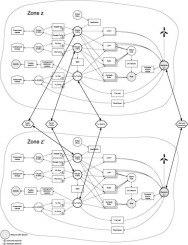Applied Energy ( IF 11.2 ) Pub Date : 2017-12-29 , DOI: 10.1016/j.apenergy.2017.09.055 Sheila Samsatli , Nouri J. Samsatli

|
A multi-objective optimisation model, based on mixed integer linear programming, is presented that can simultaneously determine the design and operation of any integrated multi-vector energy networks. It can answer variants of the following questions:
What is the most effective way, in terms of cost, value/profit and/or emissions, of designing and operating the integrated multi-vector energy networks that utilise a variety of primary energy sources to deliver different energy services, such as heat, electricity and mobility, given the availability of primary resources and the levels of demands and their distribution across space and time? When to invest in technologies, where to locate them; what resources should be used, where, when and how to convert them to the energy services required; how to transport the resources and manage inventory?
Scenarios for Great Britain were examined involving different primary energy sources, such as natural gas, biomass and wind power, in order to satisfy demands for heat, electricity and mobility via various energy vectors such as electricity, natural gas, hydrogen and syngas. Different objectives were considered, such as minimising cost, maximising profit, minimising emissions and maximising renewable energy production, subject to the availability of suitable land for biomass and wind turbines as well as the maximum local production and import rates for natural gas.
Results suggest that if significant mobility demands are met by hydrogen-powered fuel cell vehicles, then hydrogen is the preferred energy vector, over natural gas, for satisfying heat demands. If natural gas is not used and energy can only be generated from wind power and biomass, electricity and syngas are the preferred energy carriers for satisfying electricity and heat demands.
中文翻译:

用于设计和运行未来集成多矢量能源网络的多目标MILP模型,可捕获详细的时空依存关系
提出了一种基于混合整数线性规划的多目标优化模型,该模型可以同时确定任何集成的多矢量能源网络的设计和运行。它可以回答以下问题的变体:
就成本,价值/利润和/或排放而言,最有效的方法是设计和运行集成多矢量能源网络,该网络利用多种主要能源来提供不同的能源服务,例如热,电考虑到主要资源的可用性,需求水平及其在空间和时间上的分布,是否具有灵活性和流动性?何时投资技术,在何处找到技术;应该使用什么资源,何时何地以及如何将它们转换为所需的能源服务;如何运输资源和管理库存?
研究了针对英国的情景,其中涉及不同的主要能源,例如天然气,生物质和风能,以便通过各种能源矢量(例如电,天然气,氢气和合成气)满足对热,电和流动性的需求。考虑了不同的目标,例如最小化成本,最大化利润,最小化排放和最大化可再生能源生产,但要有适合生物质和风力涡轮机的土地供应以及最大的天然气本地生产和进口率。
结果表明,如果氢动力燃料电池汽车能够满足显着的机动性需求,那么氢就比天然气更能满足热需求,是氢的首选能源。如果不使用天然气,而只能从风力和生物质中产生能量,则电力和合成气是满足电力和热量需求的首选能源载体。



























 京公网安备 11010802027423号
京公网安备 11010802027423号